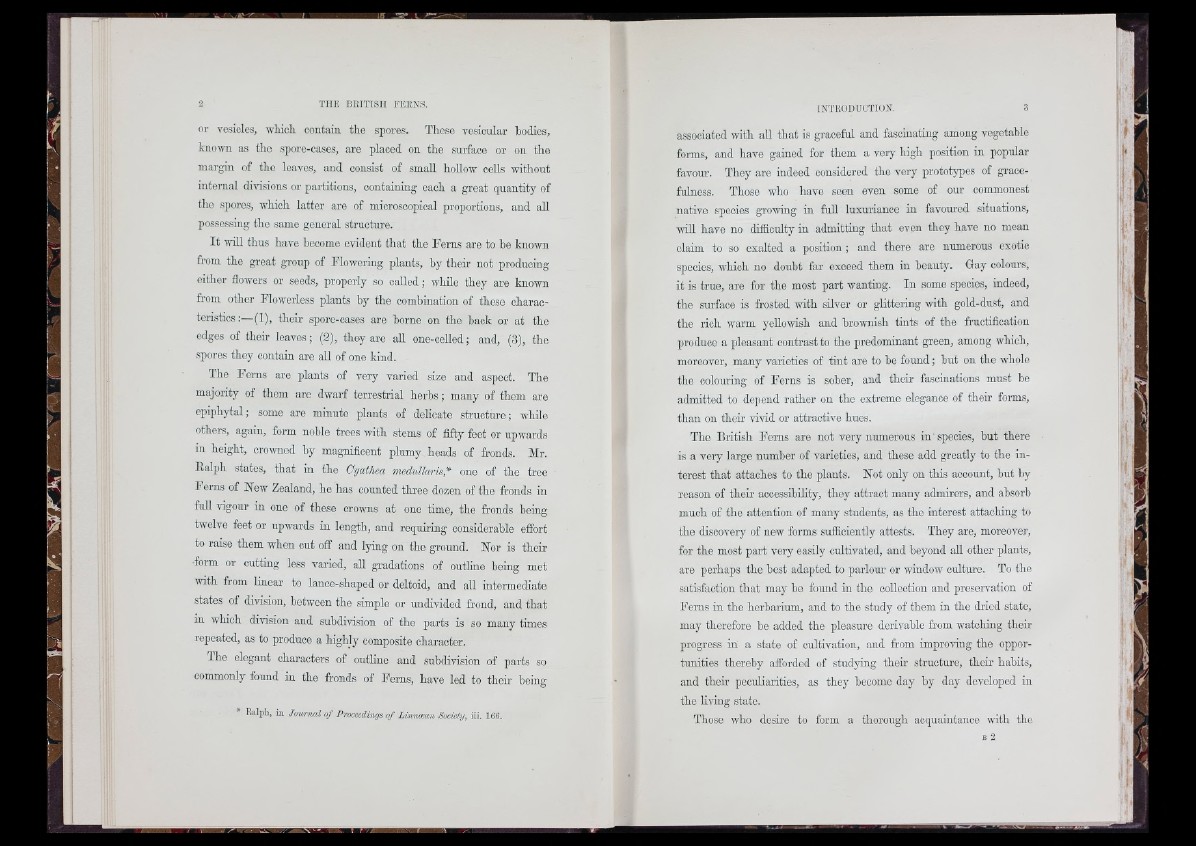
or vesicles, wliich contain tho spores. Those vesicular bodies,
knoivn as tho sporo-oases, aro placed on the surface or on the
margin of the leaves, and consist of small hollow colls without
mternal divisions or partitions, containing each a groat quantity of
tlio spores, which latter aro of microscopical proportions, and all
possessing tho same general structure.
I t will thus have booomc evident that tho Ferns are to ho known
from tho groat group of Flowering plants, by their not producing
oithor flowers or seeds, properly so called; while they aro known
from other Flowerless plants by the combination of these characteristics:—(!),
their sporo-cases aro borne on the back or at the
edges of thoir leaves; (2), they aro all ono-collod; and, (3), tho
spores they contain aro aU. of one kind.
The Ferns are jdants of very varied size and aspect. The
majority of them aro dwarf terrestrial h e rb s; many of them aro
epiphytal; some are minute plants of delicate structure; while
others, again, form noble trees with stems of fifty foot or upwards
in height, crowned by magnificent plumy heads of fronds. Mr.
Ralph states, that in tho Gyatliea medullaris* one of tho tree
Ferns of Now Zealand, he has counted three dozen of the fronds in
full vigour in one of these crowns at ono time, tho fronds being
twelve feet or upwards in length, and requiring considerable effort
to raise them when cut off and lying on the ground. Nor is their
form or cutting less varied, all gradations of outline being met
■with from linear to lance-shaped or deltoid, and all intermediate
states of division, between the simple or undivided frond, and that
in which division and subdivision of the parts is so many times
repeated, as to produce a highly composite character.
Tho elegant characters of outline and subdivision of parts so
commonly found in the fronds of Ferns, have led to their being
* Ealpli, m Journal o f Proceedings o f Linnwmi Society, iii. 166.
associated with all that is graceful and fascinating among vegetable
forms, and have gained for them a very high position in popular
favour. They are indeed considered tho very prototypes of gracefulness.
Those who have seen even some of our commonest
native species growing in fuU luxuriance in favoured situations,
will have no difficulty in admitting that even they have no mean
claim to so exalted a position; and there are numerous exotic
species, which no doubt far exceed them in beauty. Gay colours,
it is true, are for tho most part wanting. In some species, indeed,
the surface is frosted with sHver or glittering with gold-dust, and
the rich warm yeUowish and brownish tints of the fructification
produce a pleasant contrast to the predominant green, among which,
moreover, many varieties of tint are to be found; hut on the whole
the colouring of Ferns is sober, and thoir fascinations must ho
admitted to depend rather on the extreme elegance of their forms,
than on thoir vivid or attractive hues.
The British Ferns are not very numerous in species, but there
is a very large number of varieties, and these add greatly to the interest
that attaches to tho plants. Not only on this account, hut by
reason of their accessibility, they attract many admirers, and absorb
much of the attention of many students, as the interest attaching to
the discovery of new forms sufficiently attests. They are, moreover,
for the most part very easily cultivated, and beyond all other plants,
are pei’haps the best adapted to parlour or window cultm-e. To the
satisfaction th a t may bo found in the ooUoction and preservation of
Ferns in tho herbarium, and to the study of them in the dried state,
may therefore he added the pleasure derivable from watching their
progress in a state of cultivation, and from improving the opportunities
thereby afforded of studying their structure, their habits,
and their peculiarities, as they become day by day developed in
tbe Kving state.
Those who desire to form a thorough acquaintance with the
!i.
!)